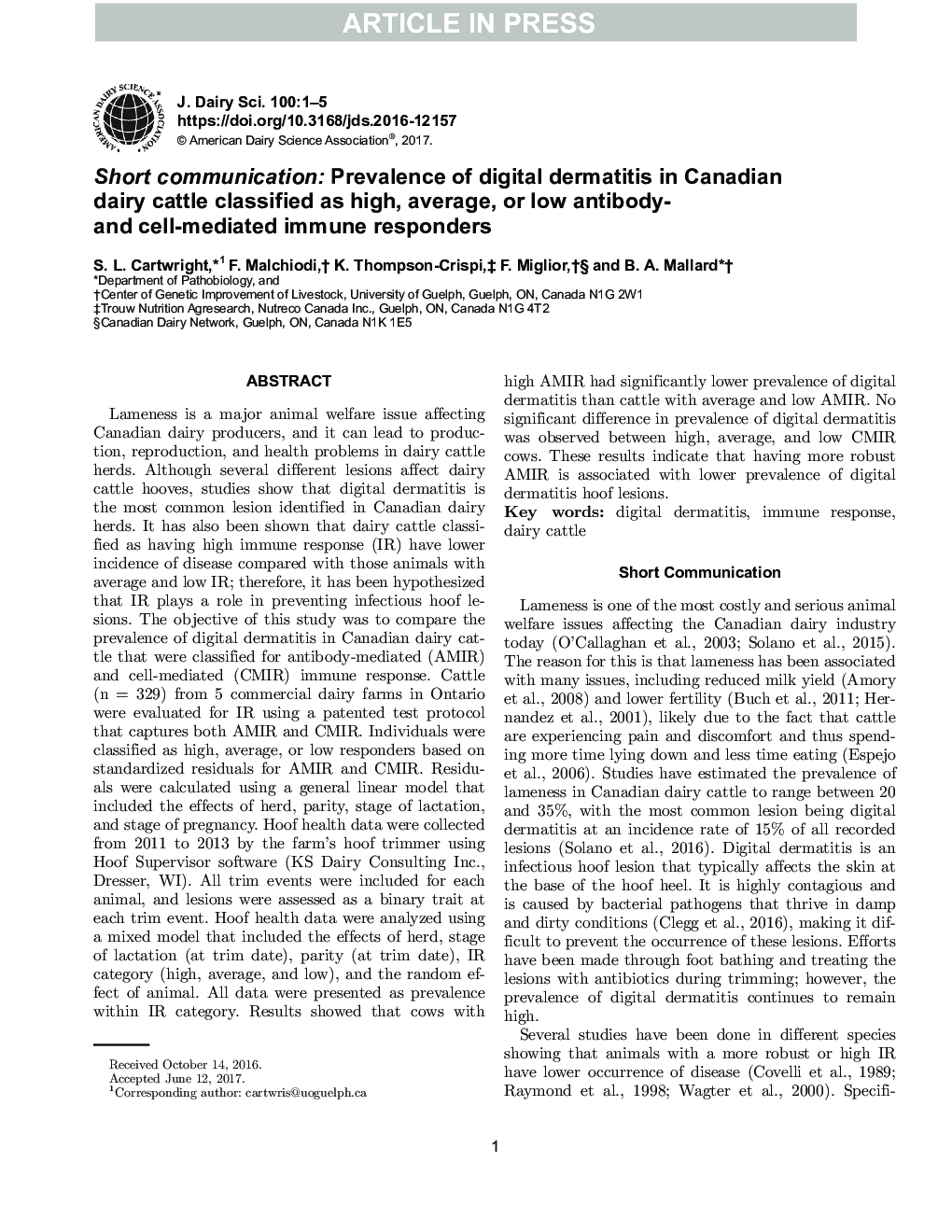| کد مقاله | کد نشریه | سال انتشار | مقاله انگلیسی | نسخه تمام متن |
|---|---|---|---|---|
| 5542025 | 1402513 | 2017 | 5 صفحه PDF | دانلود رایگان |
عنوان انگلیسی مقاله ISI
Short communication: Prevalence of digital dermatitis in Canadian dairy cattle classified as high, average, or low antibody- and cell-mediated immune responders
ترجمه فارسی عنوان
ارتباط کوتاه: شیوع درماتیت دیجیتالی در گاوهای شیری کانادا که به عنوان پاسخ دهنده های ایمنی با آنتیبادی های بالا، متوسط یا پایین شناخته می شوند
دانلود مقاله + سفارش ترجمه
دانلود مقاله ISI انگلیسی
رایگان برای ایرانیان
کلمات کلیدی
درماتیت دیجیتال، پاسخ ایمنی، احشام لبنیاتی،
موضوعات مرتبط
علوم زیستی و بیوفناوری
علوم کشاورزی و بیولوژیک
علوم دامی و جانورشناسی
چکیده انگلیسی
Lameness is a major animal welfare issue affecting Canadian dairy producers, and it can lead to production, reproduction, and health problems in dairy cattle herds. Although several different lesions affect dairy cattle hooves, studies show that digital dermatitis is the most common lesion identified in Canadian dairy herds. It has also been shown that dairy cattle classified as having high immune response (IR) have lower incidence of disease compared with those animals with average and low IR; therefore, it has been hypothesized that IR plays a role in preventing infectious hoof lesions. The objective of this study was to compare the prevalence of digital dermatitis in Canadian dairy cattle that were classified for antibody-mediated (AMIR) and cell-mediated (CMIR) immune response. Cattle (n = 329) from 5 commercial dairy farms in Ontario were evaluated for IR using a patented test protocol that captures both AMIR and CMIR. Individuals were classified as high, average, or low responders based on standardized residuals for AMIR and CMIR. Residuals were calculated using a general linear model that included the effects of herd, parity, stage of lactation, and stage of pregnancy. Hoof health data were collected from 2011 to 2013 by the farm's hoof trimmer using Hoof Supervisor software (KS Dairy Consulting Inc., Dresser, WI). All trim events were included for each animal, and lesions were assessed as a binary trait at each trim event. Hoof health data were analyzed using a mixed model that included the effects of herd, stage of lactation (at trim date), parity (at trim date), IR category (high, average, and low), and the random effect of animal. All data were presented as prevalence within IR category. Results showed that cows with high AMIR had significantly lower prevalence of digital dermatitis than cattle with average and low AMIR. No significant difference in prevalence of digital dermatitis was observed between high, average, and low CMIR cows. These results indicate that having more robust AMIR is associated with lower prevalence of digital dermatitis hoof lesions.
ناشر
Database: Elsevier - ScienceDirect (ساینس دایرکت)
Journal: Journal of Dairy Science - Volume 100, Issue 10, October 2017, Pages 8409-8413
Journal: Journal of Dairy Science - Volume 100, Issue 10, October 2017, Pages 8409-8413
نویسندگان
S.L. Cartwright, F. Malchiodi, K. Thompson-Crispi, F. Miglior, B.A. Mallard,
